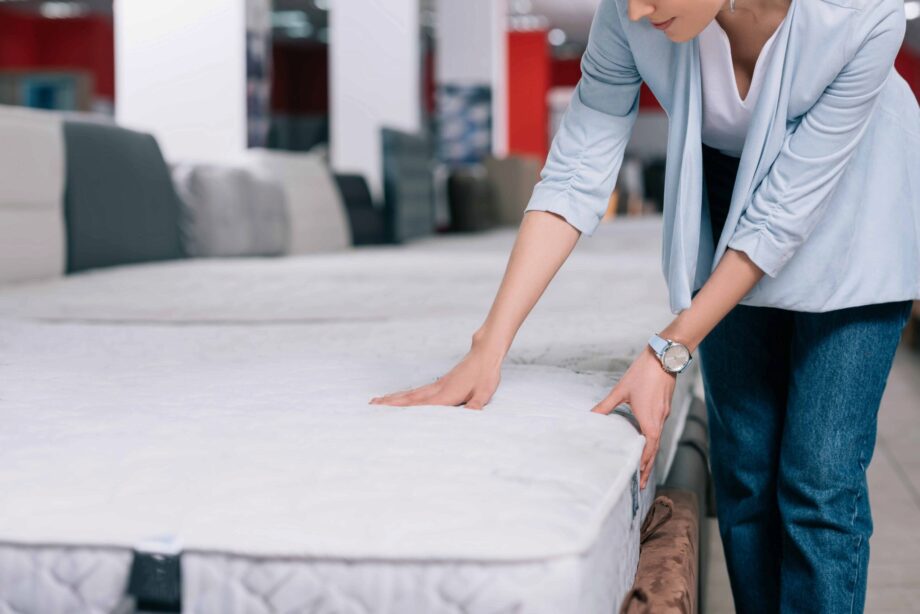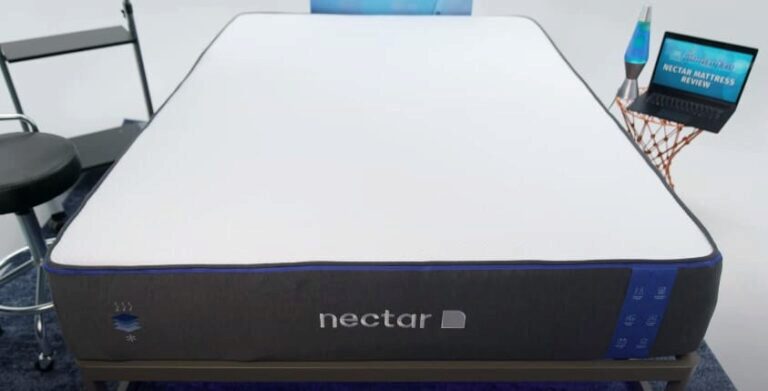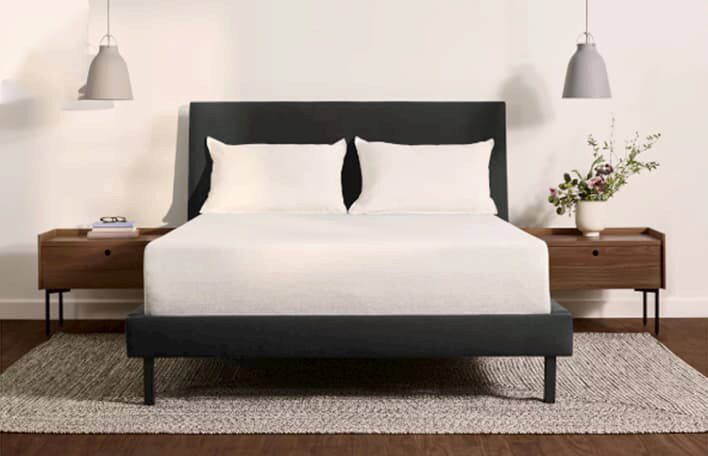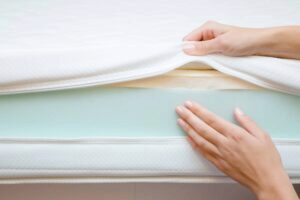Foam Vs. Spring Mattress
Disclosure: By clicking on the product links in this article, Mattress Nerd may receive a commission fee at no cost to you, the reader. Read full disclosure statement.
Mattresses come in all shapes and sizes, with numerous types to choose from. Whether you’re looking for a mattress to relieve pain symptoms, one that keeps you cool at night, or one that supports your preferred sleep position—they are a plethora of options available.
So how do you choose? We believe that one of the best ways to easily identify the ideal mattress is to learn about the types of mattresses on the market and the materials they are made with.
Today, we’re comparing memory foam mattresses and innerspring mattresses. We’ll explain the similarities and differences of each mattress type, how they feel, as well as, the pros and cons of each. That way, you can decide which option is best suited to your needs.

What is Foam?
Foam, or memory foam was invented by NASA in the 1960s. This type of mattress is composed of a polyurethane foam material also referred to as synthetic viscoelastic memory foam and is sensitive to body weight and body temperature. The construction of the foam is an open bubble cell that creates a matrix that promotes airflow. This makes it especially effective in conforming to an individual’s body, relieving pressure points, and regulating temperature. To learn more, check out our article, “What Is Memory Foam?“
PROS
- Cradles and hugs the body
- Soft material that absorbs the areas of the body that need pressure relief
- Isolates motion (great for couples or those who share their bed)
- Great mattress for side sleepers
CONS
- Does not transfer heat as well, but new cooling technologies help
- Does not respond quickly to movement
- The mattress may have a slight odor, especially when it is first unpacked
- Higher price point on some styles
What are Springs?
Springs, innersprings, or coils are the most traditional of all mattress types. Invented in 1871 by Heinrich Westphal, the innerspring or coil mattress is made of a continuous coil construction that consists of numerous rows of s-curved wires. They work by contracting as weight is applied and bind together to create a support system in which each coil draws support from its neighbor.
Innerspring mattress construction has been perfected over the years and you will often see them today as a pocketed coil system which lends itself to greater comfort and motion isolation. Coils are known for offering significant support, particularly for heavier individuals and those suffering from back pain. Because of their open-cell design, they are excellent at promoting airflow for those whose body heat rises when they sleep.
PROS
- Affordable
- Responsive, adds a bit of bounce
- Provides firmness and support
- Among the coolest mattresses available, thanks to airflow between coils
CONS
- May be too firm for some
- Can be noisy when you move around
How Foam Coils Measure Up
Overall Feel
Memory foam is a softer texture, and is built to absorb the cradle the body. Some prefer the cloud-like comfort of memory foam over the metal coils of an innerspring mattress. However, you might be surprised to learn that some actually prefer the firmer feeling of an innerspring mattresses and require the extra support they give. So, it’s really up to your personal preference to decide which feels better to you.
Cooling Properties
Innerspring mattresses are far better at cooling sleepers because of their open cell design which promotes air flow. The design of foam, however, is more narrow and does not support airflow as well as a coil system. It is worth nothing, however, that mattress manufacturers have developed new foam technologies in recent years that are better able to circulate air and regulate temperature. Many proprietary foams include an advanced open cell structure and cooling gel to regulate body temperature. Want to stay cool? Check out these tips to staying cool while you sleep.
Motion Transfer
Because of its absorbent nature, foam is really excellent at isolating motion Because and therefore will be far less likely to transfer motion at night, potentially disrupting your bedmate. The obvious trade off, however, is that a mattress that doesn’t transfer motion is typically less responsive. This can make position changes, getting in and out of bed, and any other nocturnal activities a bit more challenging.
Support
In terms of support, innerspring mattresses and memory foam both do a good job. With metal coil mattresses, the springs compress as you move to provide firm support while memory foam mattresses are constructed with both comfort layers and high-density support layers which seek to mimic the spinal alignment and stability of their counterpart. And before you dismiss foam mattresses for being too soft, remember that you can order them in varying degrees of firmness if you require extra support.
Which is Right For You?
Foam is a great choice if you desire a supportive mattress with a comfortable touch. While the higher layers are typically crafted with soft foams and gels, the lower base layers tend to be constructed of high-density foam. This provides a viable substitute for an innerspring mattress in terms of compression and alignment.
In addition, you can add pressure point relief and motion isolation to the list of benefits. This is great news for side or combination sleepers and couples. But hot sleepers will want to avoid foam or choose a foam mattress with cooling properties.
Springs are the oldest mattress technology around, but their benefits in terms of support and ease of movement remain popular today. Also, hot sleepers tend to prefer the open-cell design of an innerspring mattress over foam which can be more prone to trap heat. The drawback to springs, however, is that their metal construction is clearly less comfortable than foam and doesn’t cradle the body as well as foam.
Ultimately, it will be up to you to decide which type of mattress is best for you. Memory foam mattresses are far more popular than traditional innerspring mattresses. So if you’re considering one but have reservations about the support, keep in mind that you can order a firm memory foam mattress and still retain the added comfort benefits. The same can be said for hot sleepers. If this is your area of concern, we suggest reviewing some of the options we’ve picked out that include memory foam mattresses with cooling technology.
Our Favorite Foam Mattresses
See all of our top picks for the best foam mattresses!
The Nectar is a value memory foam mattress that excels at providing pressure relief and minimizing motion transfer. The medium-firm feel is ideal for cradling pressure points. Plus, it comes with a yearlong trial period and Lifetime warranty.
We recommend this mattress for the following sleeper types: Financing options are available for this mattress. The Nectar is a value memory foam mattress that excels at providing pressure relief and minimizing motion transfer. The medium-firm feel is ideal for cradling pressure points. Plus, it comes with a yearlong trial period and Lifetime warranty.
We recommend this mattress for the following sleeper types: Financing options are available for this mattress. The Nectar is a value memory foam mattress that excels at providing pressure relief and minimizing motion transfer. The medium-firm feel is ideal for cradling pressure points. Plus, it comes with a yearlong trial period and Lifetime warranty.
We recommend this mattress for the following sleeper types: Financing options are available for this mattress.Nectar Mattress

Material
Foam
Trial Period
365 nights
Shipping Method
Free shipping
Firmness
Medium-firm: 6/10
Warranty
Lifetime warranty
Price Range
$$$$$
Joint Pain
This bed is perfect for anyone suffering from joint pain.
Hip Pain
This bed is perfect for anyone suffering from hip pain.
Back Sleeping
Ideal for lightweight and average weight back sleepers.
Side Sleeping
Ideal for lightweight and average weight side sleepers.
Financing Options
Nectar Mattress

Material
Foam
Warranty
Lifetime warranty
Firmness
Medium-firm: 6/10
Shipping Method
Free shipping
Trial Period
365 nights
Price Range
$$$$$
Joint Pain
This bed is perfect for anyone suffering from joint pain.
Hip Pain
This bed is perfect for anyone suffering from hip pain.
Back Sleeping
Ideal for lightweight and average weight back sleepers.
Side Sleeping
Ideal for lightweight and average weight side sleepers.
Financing Options

Nectar Mattress
Material
Foam
Firmness
Medium-firm: 6/10
Trial Period
365 nights
Warranty
Lifetime warranty
Shipping Method
Free shipping
Price Range
$$$$$
Joint Pain
This bed is perfect for anyone suffering from joint pain.
Hip Pain
This bed is perfect for anyone suffering from hip pain.
Back Sleeping
Ideal for lightweight and average weight back sleepers.
Side Sleeping
Ideal for lightweight and average weight side sleepers.
Financing Options
field_page_blocks_blocks_wysiwyg_bound
Read our full Layla mattress review for more info.
field_page_blocks_blocks_wysiwyg_bound
See our full Saatva mattress review to learn more.
The Casper Wave Hybrid strikes a balance with a middle-of-the-road firmness level and features that make it appropriate for sleepers of all shapes and sizes. It’s an excellent choice for those who enjoy the Original Casper’s balance of conforming support but want more bounce.
We recommend this mattress for the following sleeper types: Financing options are available for this mattress. The Casper Wave Hybrid strikes a balance with a middle-of-the-road firmness level and features that make it appropriate for sleepers of all shapes and sizes. It’s an excellent choice for those who enjoy the Original Casper’s balance of conforming support but want more bounce.
We recommend this mattress for the following sleeper types: Financing options are available for this mattress. The Casper Wave Hybrid strikes a balance with a middle-of-the-road firmness level and features that make it appropriate for sleepers of all shapes and sizes. It’s an excellent choice for those who enjoy the Original Casper’s balance of conforming support but want more bounce.
We recommend this mattress for the following sleeper types: Financing options are available for this mattress.Casper Wave Hybrid Mattress

Material
Hybrid
Trial Period
100 nights
Shipping Method
Free shipping
Firmness
Medium-soft: 5/10
Warranty
10-year limited warranty
Price Range
$$$$$
Seniors
This bed is perfect for senior sleepers.
Back Pain
This bed is perfect for anyone suffering from back pain.
Back Sleeping
Ideal for lightweight and average weight back sleepers.
Side Sleeping
Ideal for lightweight, average weight, and heavyweight side sleepers.
Financing Options
Casper Wave Hybrid Mattress

Material
Hybrid
Warranty
10-year limited warranty
Firmness
Medium-soft: 5/10
Shipping Method
Free shipping
Trial Period
100 nights
Price Range
$$$$$
Seniors
This bed is perfect for senior sleepers.
Back Pain
This bed is perfect for anyone suffering from back pain.
Back Sleeping
Ideal for lightweight and average weight back sleepers.
Side Sleeping
Ideal for lightweight, average weight, and heavyweight side sleepers.
Financing Options

Casper Wave Hybrid Mattress
Material
Hybrid
Firmness
Medium-soft: 5/10
Trial Period
100 nights
Warranty
10-year limited warranty
Shipping Method
Free shipping
Price Range
$$$$$
Seniors
This bed is perfect for senior sleepers.
Back Pain
This bed is perfect for anyone suffering from back pain.
Back Sleeping
Ideal for lightweight and average weight back sleepers.
Side Sleeping
Ideal for lightweight, average weight, and heavyweight side sleepers.
Financing Options
Read our full Casper Wave Hybrid mattress review to learn more.


